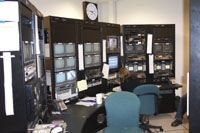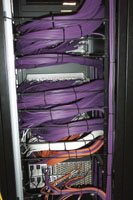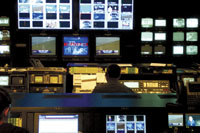KUTV’s downtown move
When KUTV-TV, a CBS-owned-and- operated station in Salt Lake City, UT, made the decision in 2003 to move from its outmoded facilities in West Valley, UT, to a new location, it was easy to see why. The station was bursting at the seams with the addition of new equipment for its digital broadcasts. And, the new downtown location was in a beautiful, centrally located building just minutes away from the city’s center.

The feed room controls incoming ENG and SNG feeds for live and delayed remote news production. Feeds may be recorded in the room, or edited packages brought to the room on tape for playback during newscasts.
It was important to involve an experienced systems integrator to handle every phase of the operation — from the design to the actual move — because the station had to continue broadcasting even during the move. With a project like this, good planning would be key to a successful transition.
After evaluating a number of integrators, KUTV chose Harris Broadcast Communication Division’s Studio Products and Systems business unit. Working with building management, architects, electricians, lighting consultants, general contractors and an equipment list, station engineers met with a team from the integrator to come up with a facility that would be eye-catching, functional and conducive to the delivery of a quality product to their Utah audience.
The new facility in the Wells Fargo Building required substantial reconstruction. Remodeling the space required compression of several functions into a much smaller space, including news, the news studio and the production control room for news.

A rack in the technical core area shows well-planned wiring paths, and wires color coded for varying signal types. Where practical, wiring is nested into the 4-inch space between racks, to improve access to equipment rear panels.
The new location was designed to include the Salt Lake City cityscape as backdrop to the news studio. Camera shots of the anchor desk have Main Street as a backdrop, through new windows constructed of bulletproof glass. The public can now walk by and see the studios, the production control room with the monitor wall, and the newsroom in operation. Special gel curtains correct for the difference between indoor and outdoor light during daylight hours, and opaque curtains can be dropped into place when desired. All of this gives the station a feel of immediacy and connection with the public that was impossible in the station’s former location.
The professional video industry's #1 source for news, trends and product and tech information. Sign up below.
The new facility is also equipped with outdoor curbside connections to allow camera shots to originate outdoors. The station now includes outdoor shots in every newscast. This new setup gives the station’s weather talent an opportunity to interact with the public during their outdoor forecasts.
The first broadcast from the new location was an outdoor debate between the incumbent mayor and his challenger that took place just outside the studios. The feedback from the public so far has been positive, with a corresponding increase in ratings.
The location includes access to the helicopter landing pad and antenna deck on the 25th floor, affording line of sight paths to virtually the entire valley. In addition to an ENG antenna array located on the 25th floor balcony, microwave relays link several hilltops with the station, enhancing KUTV’s ENG presence. The top deck of the parking structure next door is home to satellite antennas and a satellite shack housing receivers, IRDs and communications. All signals going to and from the 25th floor and the satellite shack are carried via fiber, including IP telephone instruments.

Remodeling the space in the Wells Fargo Building required KUTV-TV to compress several functions into a smaller space, including the production control room for news.
The station was already using embedded audio in its high-definition master control program chain, with good results. This positive experience led to the decision to build the new SD plant using embedded technology. All routed audio is embedded upstream of the router, or is embedded native to the source devices. It is de-embedded locally, as required, downstream for processing and monitoring. Master control utilizes embedded audio exclusively. Utah Scientific previously supplied an HD router and master control for the station. Satisfaction with this system was a significant factor in the station’s decision to build the new SD plant around a 128x128 Utah-400 wideband router and master control.
Budget considerations demanded preservation of the existing analog videotape and server technologies. Thus, all legacy videotape and server sources and destinations utilize D/A and A/D signal conversion, as well as audio embedding and de-embedding. Evertz supplied the conversion, embedding, de-embedding and fiber optic transport technologies, in addition to designing a few new products for first use at KUTV. Among these is an AES distribution amplifier with a full-bandwidth analog audio stereo pair output. Also, Evertz supplied analog component-to-serial digital video converters with audio embedding, and the companion serial digital video-to-analog component video converters with audio de-embedding. The installed base of embedding and de-embedding instruments can be repurposed over the years as technologies within the system are changed. This would not have been possible if, for example, SDI and AES retrofits had been purchased for videotape machines.
The move was structured around an inflexible schedule, and required careful planning. The master control room and technical core facilities were built onto a mezzanine, a floor constructed halfway between the basement floor level and the ceiling 24 feet above it. This part of the plant lies beneath the street-level newsroom, news studio and production control room. Engineers and technicians designed and assembled as much of the plant as possible at Harris’ facilities in Mason, OH. The systems were shipped with wire harnesses in place to Salt Lake City, then forklifted into place on the mezzanine through a hole that had been left in the wall for this purpose. The wall was enclosed after the equipment was delivered.
As the time came for the master control room to move, a partnership between station engineers and integration personnel enabled orderly transport, test and configuration of the necessary pieces. Because of redundancy among servers, videotape facilities and satellite receiving systems, it became possible to move master control in two phases. Phase One moved standby equipment to the new facility and configured it for the new location on the Saturday following Thanksgiving, while the old master control continued to operate for one more day. Phase Two commenced when the new master control was on the air. During Phase Two, the balance of the master control equipment was moved, configured and made available for use. Utah Scientific engineers made several visits to help, configure and troubleshoot during the transition.
While Phase Two was beginning, preparations were being completed to move the production control room the following weekend. The station rented a production truck and produced the news outdoors during the weekend while the production facilities were moved. The station integrator partnership during this move was key to its success. The new environment required some adjustment on the part of the people working in it, but adjustment was rapid and the transition was unnoticeable to the viewing public.
In addition to the Utah Scientific and Evertz core equipment, the facility utilizes a Ross Synergy 4 switcher that was in operation in the former location, and a new Euphonix MaxAir audio mixer. Miranda Kaleido gear provides multi-image displays via VGA splitters to Clarity flat plasma screens in the monitor wall, and to several 17-inch flat plasma displays located at the director, producer and audio operator positions. A Clear-Com Matrix intercom system is used in conjunction with legacy RTS TW gear.
The project team was able to work together to design and execute a highly complex operation. The successful effort proved that a move of this complexity can be done in a timely manner and with a minimum of disruption to the station’s on-air product. BE
Tom Norman, CPBE, is a systems engineer with Harris.
